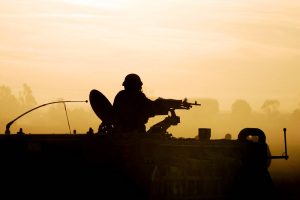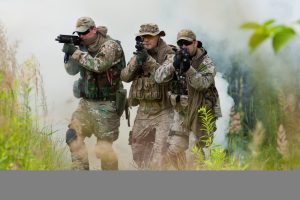
Have you ever considered the differences between the Army and the Marines? Let’s talk troops and tradition. Picture the Marines and Army, two pillars of American military might with their storied histories and distinct battle cries.
Dig into this read to understand what sets these forces apart, from their inception during America’s fight for independence to how they tackle today’s global challenges. You’ll discover who hits the ground running when speed is key versus who digs in for the long haul on battlegrounds far from home.
Stick around as we march through training regimens that turn civilians into warriors, dissect hierarchy and headcounts, and dive deep into joint operations where each branch shines in its own right. It’s not just about firepower; it’s a tale of heart, hustle, heritage—and you’re about to discover why.
Army vs Marines Table of Contents:
- Branch Origins and Core Missions
- Structure and Size
- Training Regimens and Specialization
- Roles in Joint Operations and Warfare
- Equipment and Technology
- Career Opportunities and Progression
- Culture and Traditions
- Conclusion
Branch Origins and Core Missions
The Birth of the Army vs Marine Corps
The U.S. Army, born on June 14, 1775, is the oldest military branch with a mission to protect America’s freedom. Just months later, on November 10th, the Marine Corps burst onto the scene. Their origins stem from a need for sharpshooters to fight aboard naval vessels—thus beginning their legacy as an amphibious warfare force.
Defining Missions
These two branches’ differences go beyond birthdays; they’re defined by distinct missions shaping our national defense strategy. The Army has evolved into a powerhouse focused on sustained land combat operations—a true force across vast battlefields.
In contrast, think of Marines as your rapid response team—they’ve got agility packed into their DNA. This branch is tailored for quick deployments anywhere around the globe when crises strike.
Structure and Size
Organizational Hierarchy
The Army might look like a giant when you stack it against the Marine Corps, but don’t let the size fool you. Each branch packs a punch with its unique command structure. The Army’s hierarchy is vast, from squad leaders to the Pentagon bigwigs. It’s got layers on layers of command that make sure every soldier has their orders straight.
In contrast, do the Marines run a tighter ship or platoon? Their streamlined chain of command ensures rapid decision-making, which is crucial for their role as America’s 911 force.
Read more about Army jobs here!
Personnel Numbers
Talking numbers: over 480,000 soldiers fill out the ranks in the Army, making it Uncle Sam’s biggest battalion by far. But don’t count out the Marine Corps; these warriors stand strong at approximately 186,000 active-duty members who are always ready to leap into action.
Training Regimens and Specialization
We are examining the training processes for recruits in both branches, including boot camp intensity, duration, and specialized training opportunities.
Boot Camp Intensity
You describe the rigorous nature of Marine Corps boot camp compared to Army basic training.
The sweat, the grit, the challenge—Marine Corps boot camp is notorious for its intensity. Spanning a demanding 13 weeks, it’s where recruits are pushed to their limits both physically and mentally. Unlike Army basic training, which can vary from 10 to as much as 22 weeks depending on one’s Military Occupational Specialty (MOS), every Marine endures the same length of initial training regardless of their future role.
Core Areas of Focus in Army Training
In the Army, the training process is meticulously designed to build a well-rounded soldier. During the initial ten weeks of basic training, recruits are immersed in the fundamentals of discipline, teamwork, and survival. This phase is crucial for developing both physical and mental resilience.
- Core areas of focus: The Army emphasizes camaraderie, adaptability, and leadership, ensuring that each soldier not only learns to work as part of a team but also develops the ability to lead under challenging circumstances.
Advanced Individual Training
We are exploring how each branch approaches specialized training post-boot camp.
Moving beyond the basics, each branch offers tailored pathways post-boot camp. The Marines continue with Infantry Training Battalion or other specialized schooling based on military function—a relentless drive towards operational excellence. Meanwhile, soldiers in the Army encounter an array of options; they embark on Advanced Individual Training that aligns with their chosen MOS—a direct pipeline into technical expertise.
- Advanced opportunities: Army soldiers have the chance to train at prestigious institutions, such as the U.S. Military Academy at West Point, which emphasizes strategic thinking and tactical proficiency.
- Key attributes developed: Through these comprehensive training programs, soldiers cultivate teamwork, resilience, and problem-solving skills under pressure, preparing them to excel in various military roles.
Roles in Joint Operations and Warfare
What are the Key Attributes of the Army’s Support Systems?
The Army’s support systems are crucial for maintaining efficiency and effectiveness in diverse operational scenarios. Here are the fundamental components that define these systems:
- Comprehensive Supply Chains: The Army maintains an extensive network to deliver essential supplies, including equipment, food, and ammunition. This ensures that units have what they need to operate effectively, no matter where they are deployed.
- State-of-the-Art Medical Facilities: With cutting-edge medical support and mobile field hospitals, soldiers receive immediate care and attention. These facilities are critical in managing injuries and maintaining troop health in challenging environments.
- Engineering Expertise: Specialized engineering teams are tasked with the development and maintenance of infrastructure. They handle everything from building roads to setting up bases, ensuring the Army’s operations can be sustained over long durations.
- Specialized Transportation and Communication Systems: Effective mobility and seamless communication are facilitated through specialized networks. These systems are vital for the coordination and movement of troops and equipment across varied terrains.
These elements form a robust backbone, enabling the Army to execute large-scale missions with sustained presence and operational independence.
How Does the Marine Corps Benefit from Its Integration with the Navy?
The Marine Corps derives significant advantages from its partnership with the Navy, benefiting from shared resources and expertise that enhance their operational effectiveness.
By being part of the Department of the Navy, Marines have direct access to a vast array of naval assets. This collaboration allows for seamless joint operations, especially in sea-to-land missions. As a result, Marines are poised for efficiency when it comes to rapid deployments and specialized amphibious tasks.
Key Benefits of Marine-Navy Collaboration:
- Transportation and Deployment: Marines have access to naval fleets, facilitating swift and strategic movement to global hotspots.
- Technical Support: The Navy provides essential technical know-how for operating and maintaining advanced marine and naval equipment.
- Medical Support: Immediate medical services are available, thanks to naval hospital ships and facilities, ensuring injured personnel receive prompt care.
- Logistical Aid: The Navy assists with resupply and reinforcement logistics, vital during extensive missions.
Ultimately, the Marines’ integration with the Navy not only provides essential support but also underscores their adaptability and precision in executing diverse military operations. This relationship gives them the unique capability to focus on and excel in their specialized roles.

Equipment and Technology
Mobility and Deployment Capabilities
The Marines are known for being fast on their feet, with gear ready to move at a moment’s notice. Think of them as the sprinters in the military race, equipped for rapid deployment anywhere they’re called into action. They rely on equipment like amphibious assault vehicles, which embody their need-for-speed philosophy.
In contrast, picture the Army as marathon runners carrying heavier packs—they have an extensive collection of heavy-duty machinery tailored for prolonged land combat operations. Their arsenal includes everything from tanks to large artillery systems that aren’t just about mobility but sustained firepower over time.
This difference in approach is straightforward: while Marine Corps assets must be quick and versatile across air, land, and sea, the Army brings out the big guns with its more expansive array of robust equipment designed for long-term engagements.
What are the Key Attributes of the Army’s Support Systems?
The Army’s support systems are crucial for maintaining efficiency and effectiveness in diverse operational scenarios. Here are the fundamental components that define these systems:
- Comprehensive Supply Chains: The Army maintains an extensive network to deliver essential supplies, including equipment, food, and ammunition. This ensures that units have what they need to operate effectively, no matter where they are deployed.
- State-of-the-Art Medical Facilities: With cutting-edge medical support and mobile field hospitals, soldiers receive immediate care and attention. These facilities are critical in managing injuries and maintaining troop health in challenging environments.
- Engineering Expertise: Specialized engineering teams are tasked with the development and maintenance of infrastructure. They handle everything from building roads to setting up bases, ensuring the Army’s operations can be sustained over long durations.
- Specialized Transportation and Communication Systems: Effective mobility and seamless communication are facilitated through specialized networks. These systems are vital for the coordination and movement of troops and equipment across varied terrains.
These elements form a robust backbone, enabling the Army to execute large-scale missions with sustained presence and operational independence.
Career Opportunities and Progression
Advancement Speed
The race to the top can feel like a sprint in one branch and a marathon in another. In the Marines, promotions up to sergeant come swiftly for those who excel—think fast track. But here’s where it gets real: snagging that staff NCO spot? That’s tougher than a two-dollar steak.
In contrast, Army folks might find more predictability climbing their ladder. It’s structured with clear benchmarks along the way; think of it as having your GPS guiding you toward that next stripe or bar.
Education Benefits
If knowledge is power, then both branches are like twin nuclear reactors powering career growth. The Army gives soldiers tuition assistance through programs like GoArmyEd, fueling dreams from certificates to master’s degrees.
The Marines match this with their education perks, turning devil dogs into scholars faster than you can say ‘Semper Fi.’ They’ve got tools such as the Marine Corps Tuition Assistance Program, proving they’re just as serious about hitting the books as they are about hitting targets.
Culture and Traditions
The Army and Marine Corps are more than just military branches; they’re families with deep-rooted traditions that shape their members’ identities. Think of the Marines as your tough-love sibling, always ready to act with a “first to fight” mentality. Their birthday ball is not just a party; it’s a revered annual event where warriors in dress blues toast to battles past and bonds forged.
On the other side, you have the Army, akin to the steadfast protector of the family. They honor tradition through ceremonies like change-of-command or retirement parades that feel like passing down an heirloom watch—timeless and full of meaning.
Both services instill pride through rituals unique to their heritage. These customs aren’t just for show—they remind every soldier and marine why they serve, weaving individual stories into a larger tapestry of service before self.
At the heart of the Army’s identity lies a set of core values that guide every soldier:
- Loyalty
- Duty
- Respect
- Selfless Service
- Honor
- Integrity
- Personal Courage
These principles form the backbone of the Army’s culture, influencing everything from day-to-day interactions to strategic missions. Professionalism is not just expected; it’s a way of life that fosters an environment where individuals are encouraged to excel and contribute to the collective success of their team.
Moreover, career progression is a key pillar, with the Army offering numerous opportunities for personal and professional growth. This structure ensures that soldiers are not only part of a storied tradition but are also on a path of continual development, enhancing both their skills and their role within the broader mission.
Understanding the “Spirit of the Corps” in the Marine Corps
The “Spirit of the Corps” represents the unique ethos that defines the Marine Corps, distinguished by profound pride and camaraderie among its members. This spirit is not confined to periods of active duty; rather, it forges a lifelong identity for those who have donned the uniform.
Core Values: The Foundation
At the heart of this spirit are three core values:
- Honor: This principle drives Marines to act with integrity and uphold the moral and ethical code expected of them.
- Courage: Marines are encouraged to face both physical and moral challenges with bravery.
- Commitment: Dedication to the Corps, fellow Marines, and mission success is paramount.
These beliefs permeate every aspect of a Marine’s life, influencing decisions and interactions.
Lifelong Brotherhood and Sisterhood
The Marine Corps fosters a tight-knit community that transcends geographical and temporal boundaries. Whether stationed on a base at home or deployed overseas, Marines experience a deep sense of connection.
The saying “Once a Marine, always a Marine” underscores the enduring impact of this service. It speaks to the lifelong bonds formed through shared experiences and challenges that Marines face together.
In essence, the “Spirit of the Corps” is the embodiment of a community bound by shared values and unwavering loyalty, creating a lasting impact on those who serve.
Conclusion
So, you’ve marched through the details—Army vs Marines—two forces unique in their might and mission.
You now know the roots run deep for both, born from America’s bold bid for freedom. The Army brings numbers; the Marines bring agility.
Boot camp breaks them down to build them up—Marines endure longer weeks, while Army training varies with the role.
In joint operations, it’s clear: Marines strike fast and hard; the Army holds ground over time.
Different gear for fights—from rapid deployment to heavy artillery—and each branch shapes its warriors with distinct cultures that echo tradition and pride.
This isn’t just about uniforms or ranks—it’s about understanding two pivotal pieces of a complex defense puzzle. And now, you do.
Want more military info? Find your nearest military recruiter here!
